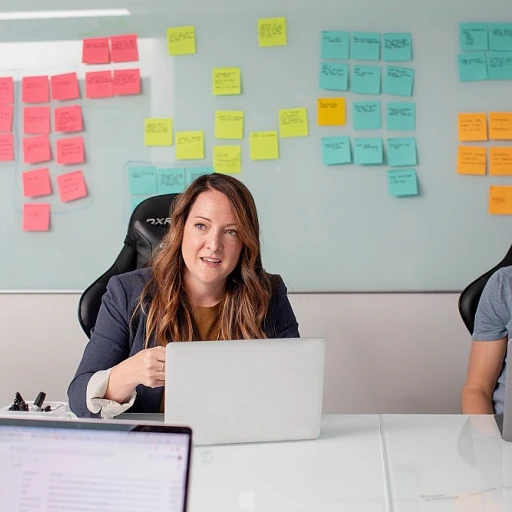
Understanding the Skills Gap
Dissecting the Skills Gap in Today's Work Environment
The skills gap is a pressing issue for countless employees and organizations. As industries evolve and new technologies emerge, job requirements transform rapidly, leaving a disparity between existing employee skills and the skills required to perform effectively.
From an employer's perspective, this gap is not just about missing technical skills. It encompasses soft skills such as communication, teamwork, and problem-solving. For instance, a closer look at skills evaluations shows the importance of a comprehensive approach in identifying these gaps.
Regular check-ins through one-on-one meetings play a crucial role here. Each meeting with your direct reports can be a golden opportunity to discuss and pinpoint areas where skill enhancement is needed, aligning them with team goals and action items. With a structured meeting agenda, employees can receive targeted feedback that directly addresses their development needs.
The proactive use of meeting templates ensures that every one meeting is productive. By using a meeting template, you can establish a consistent framework to talk about skill development every time you sit down with a team member. Printable PDFs, Google Docs, or any free template available online can be customized to suit the unique needs of your team.
Organizations striving to bridge this gap must therefore recognize the importance of regular and structured conversations. This commitment will improve employee performance and ultimately contribute to achieving organizational goals.
The Role of 1-on-1 Meetings in Addressing Skills Gaps
The Impact of Personalized Check-Ins
One-on-one meetings play a significant role in addressing skills gaps by enabling personalized interactions between managers and employees. These meetings provide a structured platform where both parties can focus on individual employee development and work towards closing any existing skills gaps.Facilitating Open Communication
A well-structured one-on-one meeting creates a secure environment for open communication. This encourages employees to voice their concerns and provide feedback directly to their manager. Additionally, managers can offer constructive feedback and guidance on areas where the employee may need improvement, aligning on goals and action items for skills enhancement.Setting a Clear Agenda
Incorporating a clear meeting agenda helps ensure the discussion is productive and focused on the employee's development needs. A meeting template can aid in planning the discussion, covering essential topics such as current challenges, goals, and personal development plans. The agenda should include specific talking points and actionable outcomes.Regular Check-Ins on Progress
To effectively address skills gaps, regular check-ins on the employee's progress are crucial. These sessions allow both the employee and the manager to review past commitments and set new targets for continued improvement. A consistent one meeting schedule fosters a dynamic environment for ongoing skill development.Fostering a Supportive Team Environment
One-on-one meetings also contribute to creating a supportive team environment. When employees feel valued and receive the necessary support and guidance, their development progresses significantly. Team members are more engaged and motivated to achieve their best work. [Enhance managerial effectiveness and address skills gaps with essential questions to evaluate a potential employee.]Key Elements of a Successful 1-on-1 Meeting Template
Blueprinting the One-on-One Meeting
When filling in the template for your one-on-one meeting with your manager, there are certain key elements to keep in mind. To maximize the effectiveness of these sessions, a structured approach aids in laying out a clear path towards employee development and bridging the skills gap. First, setting a defined meeting agenda is essential. This provides a roadmap for the conversation and ensures that both parties are prepared. Including items for discussion such as current work progress, any arising issues, and upcoming goals helps focus the meeting time effectively. Incorporating actionable feedback is another crucial aspect. Not only does feedback facilitate professional growth, but it also increases alignment between managers and employees. Ensuring that this exchange is two-way is vital; employees should feel comfortable engaging in open dialogues and voicing any concerns or suggestions. Additionally, time management during the meetings is key to respect everyone's schedule. Adhering to a defined start and end time, possibly via a printable pdf meeting template or using platforms like google docs, ensures productivity and sets a professional tone. One-on-one meetings also serve as great opportunities to discuss longer-term development goals. Direct reports can align their personal objectives with the team's objectives, contributing to overall workplace harmony. A template that tracks these goals and progresses helps maintain transparency and accountability. Finally, action items are paramount. After each meeting, documenting agreed-upon steps for both the employee and manager closes the feedback loop and sets the stage for future check-ins. Ensuring that this documentation is accessible, perhaps through a downloadable template, underscores commitment to continuous improvement. Implementing a well-structured meeting template fosters an environment where managers and employees can collaboratively address skills gaps and drive development. For teams looking to elevate their one-on-one meetings' impact, tailor these templates to fit individual needs and dynamics, allowing for an agile approach to professional growth. For more insights on employment types and their impacts on skills gaps, consider exploring this article.Customizing Templates for Individual Needs
Personalizing Meeting Templates to Fit Unique Employee Needs
Customizing meeting templates for individual needs is a crucial step in making 1-on-1 meetings more effective. This process involves tailoring each meeting so it aligns with the employee's specific goals, challenges, and development opportunities. Here are some actionable strategies to achieve this:- Identify Unique Objectives: Understanding the unique goals and professional aspirations of each employee is fundamental. This ensures that the meeting agenda reflects what the employee aims to achieve and how these objectives align with the company’s broader goals.
- Use Varied Templates: Tools like google docs offer flexibility but consider using a variety of meeting templates. Whether it is a free template, a printable pdf, or an action items-focused template, varying the structure can cater to different developmental stages or roles of team members.
- Tailoring Feedback and Check-Ins: Effective 1-on-1 meetings should provide direct feedback tailored to the employee. Beyond generic feedback, focus on specific areas of improvement and development that are pertinent to the individual’s role.
- Adapt Agenda and Time Frame: Not every meeting requires the same agenda focus or duration. Customize the time spent on each part of the meeting based on the employee's needs. This flexibility can lead to more open and genuine discussions.
- Incorporate Ongoing Projects: Acknowledge and discuss ongoing projects or challenges specific to the direct report. This not only keeps the conversation relevant but also provides a platform for brainstorming and innovation.
- Download and Review Reports: Encourage employees to come prepared by reviewing relevant reports or presentations prior to the one meeting. This allows for more informed discussions and efficient use of the meeting time.
Overcoming Common Challenges in 1-on-1 Meetings
Addressing Challenges and Bottlenecks in 1-on-1s
Engaging in regular 1-on-1 meetings with direct reports is instrumental in bridging the skills gap. However, these sessions can encounter challenges, which, if unaddressed, may hinder their effectiveness. Understanding these hurdles is key to facilitating a more productive meeting environment. Firstly, time constraints often cause meetings to feel rushed, leading to incomplete agendas and untapped discussions. Ensuring there is ample time for each meeting allows for comprehensive check-ins with employees, enabling them to address their development goals in depth. Managers should strive to allocate sufficient blocks of time, free from interruptions, to maximize the productivity of these meetings. Another common challenge is the lack of clear meeting templates. Using a structured template can guide the meeting flow, ensuring that all necessary points are covered. Employing a meeting agenda template aids managers and employees alike in preparing for the meeting, helping to focus the discussion on crucial action items and skill enhancement. Feedback collection is another area that can pose difficulty. Open feedback is essential for meaningful development discussions. Managers should foster a culture of trust where employees feel comfortable sharing honest feedback. In some cases, offering alternate feedback channels, such as anonymous input via google docs, can encourage openness. Moreover, personalization in meetings often gets overlooked. While templates offer a framework, they need customization to address individual employee needs effectively. By tailoring the meetings to focus on the specific skills and goals of a team member, it’s possible to enhance engagement and direct reports’ development. Navigating these challenges is essential for effective 1-on-1 meetings that progress employee growth and tackle skills gaps. With the right preparation, agenda structuring, and personalized focus, these obstacles can be transformed into opportunities for meaningful employee and manager interactions. Remember, overcoming these challenges positions teams for enhanced performance and continuous improvement, laying the building blocks for future success.Measuring the Impact of 1-on-1 Meetings on Skills Development
Tracking Progress and Making Adjustments
Effectively measuring the impact of 1-on-1 meetings on skills development requires consistent monitoring and flexibility. Begin by implementing a structured framework for assessment to gauge how these meetings influence the growth of skills among employees and the team as a whole. Here are some pragmatic steps to consider:- Set Clear Objectives and Metrics: Clearly defined goals and metrics are vital. They serve as benchmarks to assess the effectiveness of your meeting agenda and templates over time. Align these with employee development plans and use them to track progress.
- Utilize Feedback Channels: Incorporate regular feedback sessions into your one meetings. Providing and receiving feedback helps in evaluating whether individual and team objectives are being met, thus ensuring continued alignment with development goals.
- Review Action Items: Regularly check in on action items discussed in previous meetings. This not only ensures accountability but also provides insights into ongoing challenges and successes, facilitating timely adjustments.
- Leverage Technology Tools: Use accessible tools like google docs and printable pdf meeting templates for effective documentation and monitoring. These tools can help managers and employees keep track of minutes purpose and action items more efficiently.
- Adjust Meeting Cadence: Be open to adjusting the frequency of the meetings based on direct reports’ development needs. The time between one meeting and the next should be adequate to work on and review actionable insights.
- Analyze Outcomes and Impact: Regularly analyze the data collected from these meetings to understand their impact on skill development. This might include surveys, performance reviews, and feedback from direct reports and team members.












